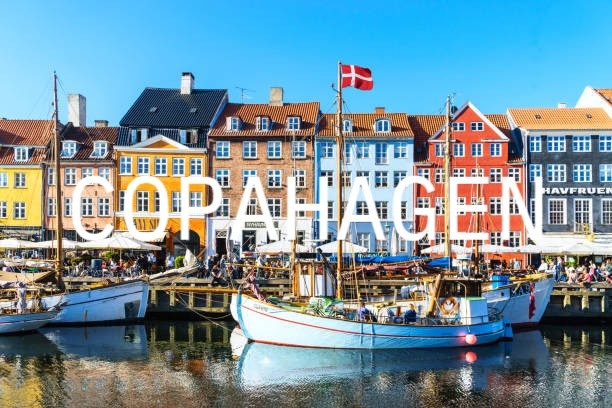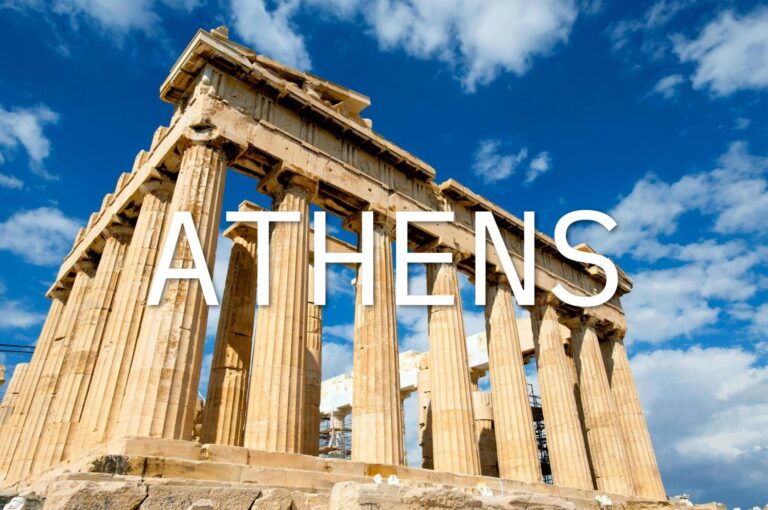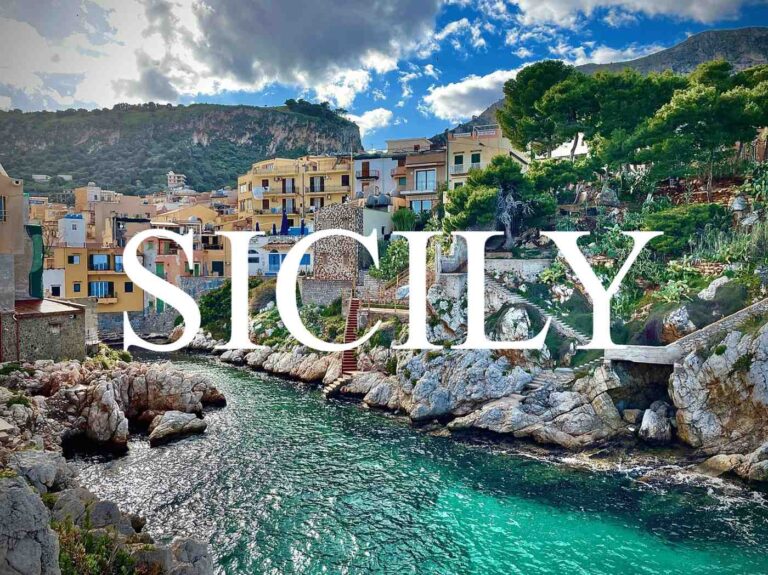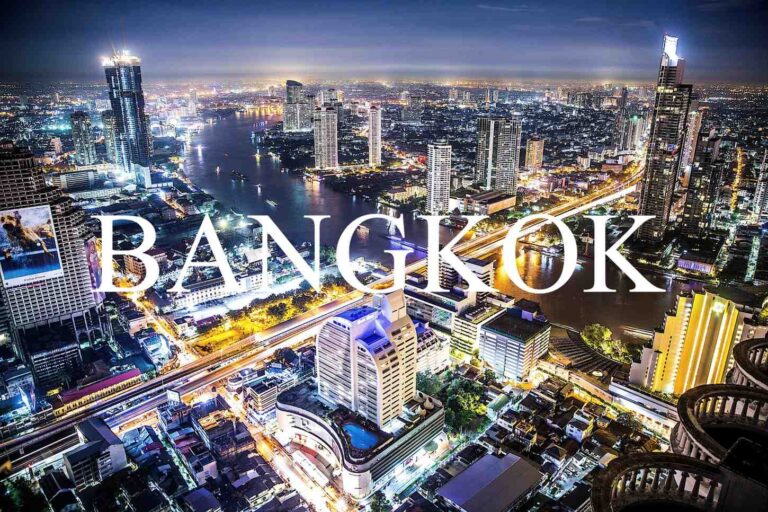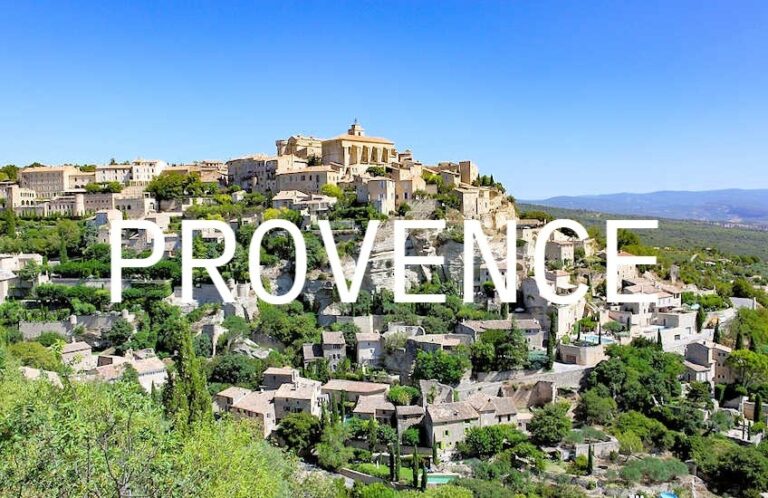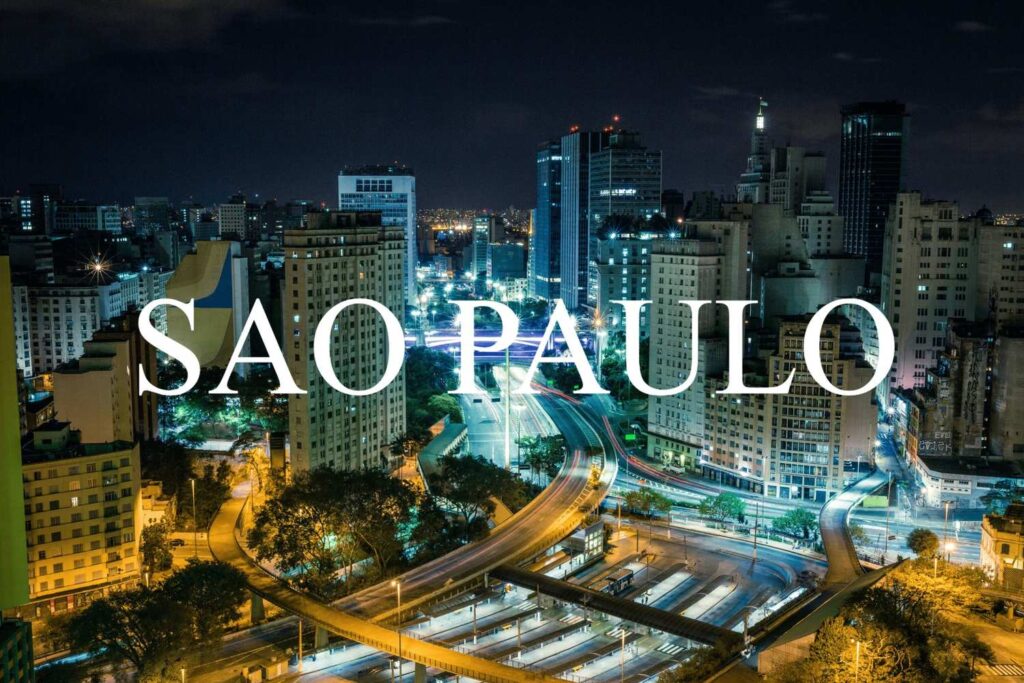
As the beating heart of Brazil, São Paulo stands as the country’s largest city and an influential cultural capital that pulses with life, creativity, and endless possibilities. A sprawling metropolis of over 12 million people, São Paulo offers a compelling blend of art, history, gastronomy, and urban charm that captivates travelers from around the globe.
From the moment you arrive, the city’s dynamic energy is undeniable. Skyscrapers tower over colonial-era buildings, while bustling markets, chic boutiques, and trendy cafes line the streets. Art lovers will be enthralled by world-class institutions like the São Paulo Museum of Art (MASP) and the immersive exhibitions at Pinacoteca do Estado. For those craving green spaces amid the urban sprawl, Ibirapuera Park provides a peaceful escape, complete with lakes, museums, and architectural wonders by Oscar Niemeyer.
Food is another cornerstone of São Paulo’s identity. As a melting pot of cultures—from Italian and Japanese to Lebanese and Afro-Brazilian—the city’s culinary scene is one of the most diverse and exciting in South America. Whether you’re sampling gourmet fare at a Michelin-starred restaurant or enjoying traditional feijoada at a local boteco, each bite tells a story.
The city’s neighborhoods are as varied as its people. Wander through the bohemian streets of Vila Madalena, brimming with street art and lively bars, or explore the upscale avenues of Jardins, home to luxury shopping and elegant cafes. Liberdade, the largest Japanese community outside Japan, offers an immersive experience into Asian culture, right in the heart of São Paulo.
São Paulo is not just a stopover—it’s a destination in its own right. With its unmatched cultural richness, buzzing nightlife, and cosmopolitan flair, this South American megacity promises an unforgettable journey for curious travelers, art enthusiasts, foodies, and history buffs alike.
🗓️ Best Time to Visit São Paulo
- ☀️ April to June (Autumn): One of the best times to visit with pleasant temperatures (18–25°C), fewer crowds, and minimal rain.
- 🌸 September to November (Spring): Mild weather and blooming jacaranda trees paint the city purple — perfect for walking tours.
- ☔ December to March (Summer): Hot and humid with occasional heavy rain, but also a time for festivals and beach day trips.
- ❄️ June to August (Winter): Cooler temperatures (11–21°C), still quite dry and comfortable for city exploring.
💵 Currency & Travel Essentials
- Currency: Brazilian Real (BRL, R$)
- Language: Portuguese (basic English in tourist zones)
- Transportation: Metro, buses, taxis, and ride-hailing apps like Uber and 99.
- Average Daily Budget:
- Budget: R$150–250
- Mid-range: R$300–600
- Luxury: R$700+
🏙️ 10 Best Places to Visit in São Paulo
Avenida Paulista
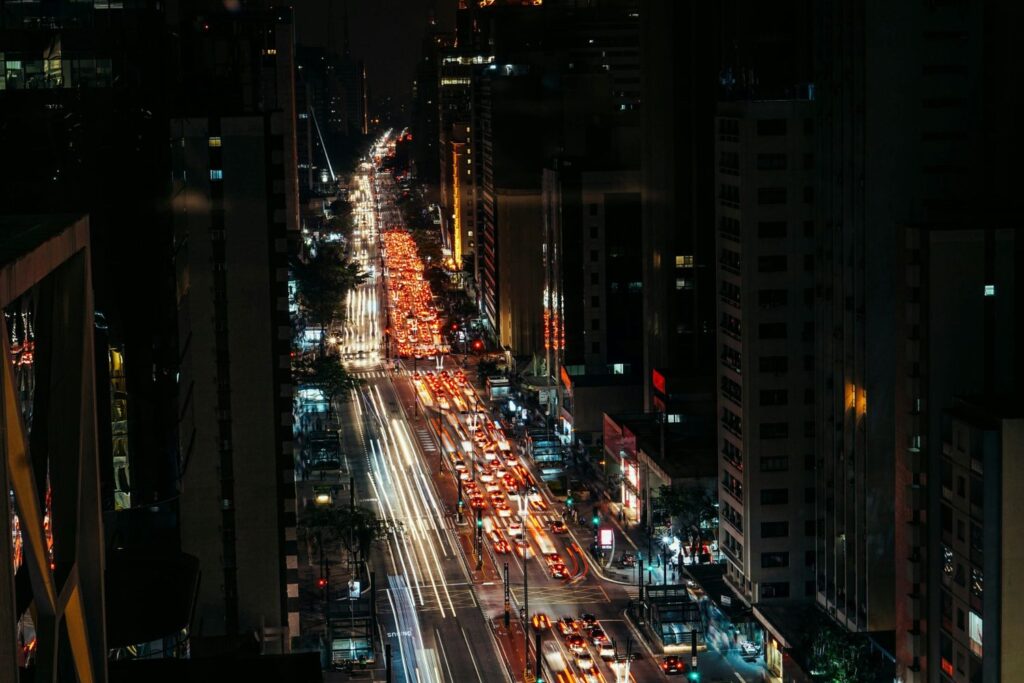
Spanning nearly 3 kilometers through the center of Brazil’s largest city, Avenida Paulista is more than just a street—it’s a dynamic hub of culture, business, art, and everyday life. Often called the “economic spine” of São Paulo, this bustling avenue is home to major financial institutions, world-class museums, shopping centers, and a diverse mix of people. Whether you’re a culture lover, architecture enthusiast, foodie, or casual explorer, Avenida Paulista offers something for everyone.
🌟 Highlights of Avenida Paulista
• 🖼️ Museu de Arte de São Paulo (MASP)
An architectural landmark and cultural treasure, MASP houses one of the most important collections of Western art in Latin America. Its modernist design and red stilts are iconic.
• 🏢 Striking Architecture
Admire a blend of glass skyscrapers, historic mansions, and bold contemporary buildings—an eclectic visual journey through São Paulo’s evolution.
• 🌳 Trianon Park (Parque Tenente Siqueira Campos)
A peaceful slice of rainforest tucked between skyscrapers, offering shaded trails and a quiet retreat from the city noise.
• 🎭 Cultural Centers & Theaters
Visit spaces like the Casa das Rosas, a literary and cultural center in a preserved historic mansion, or catch performances in nearby theaters and cultural venues.
• 🛍️ Shopping & Entertainment
Avenida Paulista is lined with high-end stores, local boutiques, bookstores, cafés, and shopping centers like Shopping Cidade São Paulo.
• 🚴 Car-Free Sundays (Paulista Aberta)
Every Sunday, the avenue transforms into a pedestrian-friendly space, with live music, food stalls, and families strolling or biking freely.
🚇 How to Get There
• By Metro:
Easily accessible from multiple metro stations including Trianon-MASP, Brigadeiro, and Consolação on Line 2 (Green Line).
• By Bus or Bike:
Numerous bus lines pass through the avenue. There’s also a dedicated bike lane along its entire length.
🕒 Visitor Information
• Always Open:
The avenue and public spaces are accessible 24/7, though individual shops, museums, and attractions have their own opening hours.
• Best Time to Visit:
Visit during the day for museums and shopping, or on Sundays for a relaxed, festive experience without cars.
💡 Travel Tips
• 👟 Wear Comfortable Shoes:
Plan to walk a lot—there’s plenty to explore along the way.
• 🎟️ Check for Events:
Avenida Paulista often hosts parades, protests, concerts, and exhibitions—especially on weekends and public holidays.
• ☕ Café Hopping Recommended:
There are numerous charming spots for Brazilian coffee, quick bites, or people-watching.
• 📸 Bring a Camera:
Perfect for street photography, urban landscapes, and snapshots of daily São Paulo life.
Avenida Paulista is a symbol of São Paulo’s diversity, creativity, and constant motion. It embodies the spirit of the city—fast-paced yet rich in culture, modern yet rooted in history. Whether you’re exploring museums, enjoying a sunny afternoon stroll, or taking in the skyline, a visit to Paulista is essential to understanding the pulse of Brazil’s most dynamic metropolis.
São Paulo Museum of Art (MASP)
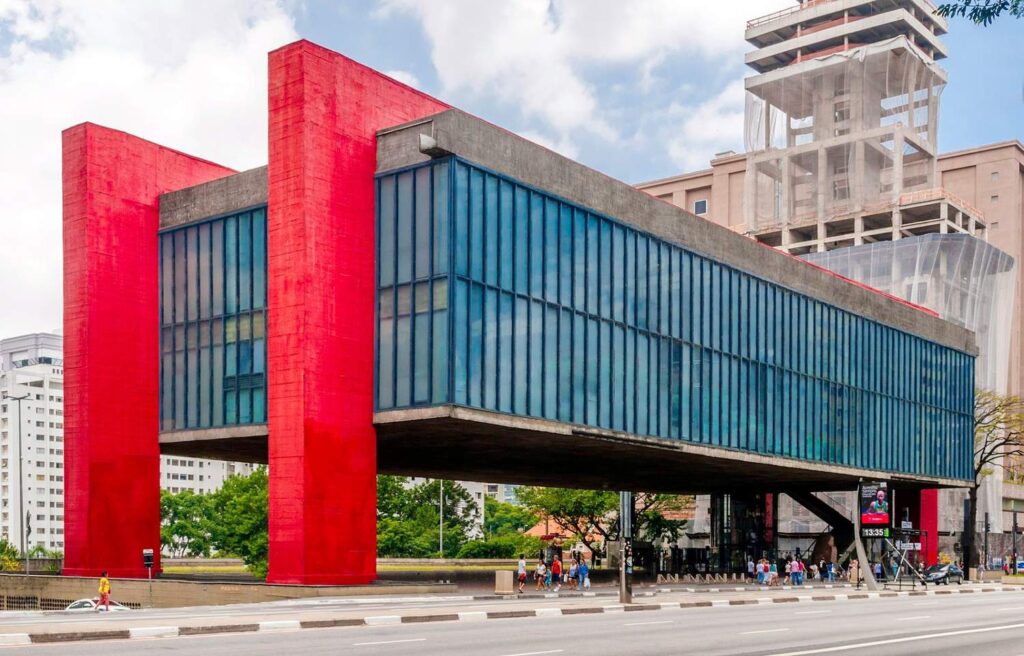
Rising above the iconic Avenida Paulista, the São Paulo Museum of Art (Museu de Arte de São Paulo – MASP) is one of Brazil’s most celebrated cultural institutions. Known not just for its world-class art collection but also for its stunning modernist design, MASP is a symbol of São Paulo’s dynamic blend of tradition and innovation. Whether you’re a seasoned art lover or a curious traveler, this museum promises a rich and memorable experience.
🌟 Highlights of MASP
• 🖼️ World-Class Art Collection
MASP houses one of the most important art collections in Latin America, including works by European masters like Van Gogh, Rembrandt, Monet, Picasso, and Botticelli, alongside Brazilian greats such as Candido Portinari and Anita Malfatti.
• 🧊 Unique Floating Design
Designed by architect Lina Bo Bardi, MASP is an architectural icon. The museum is suspended above the ground on massive red pillars, creating a dramatic open space underneath—often used for public events and gatherings.
• 🖼️ Open-Frame Display System
Inside, artworks are displayed on transparent glass panels, allowing visitors to walk around each piece and view them from all angles—an innovative curatorial approach that breaks traditional museum norms.
• 🧠 Cultural Programs & Exhibitions
MASP regularly features temporary exhibitions, lectures, films, and workshops, covering diverse themes from global art movements to Afro-Brazilian culture and contemporary issues.
• 📚 MASP Store and Library
Explore the museum’s bookstore for art catalogs, design items, and unique gifts. The on-site library is also a valuable resource for researchers and students.
🚇 How to Get There
• By Metro:
The museum is right by Trianon-MASP Station on Line 2 (Green) of the São Paulo Metro.
• By Bus or Car:
Many city buses pass along Avenida Paulista. Paid parking is available nearby, though walking or transit is often easier.
🕒 Visitor Information
• Opening Hours:
Typically open Tuesday to Sunday, with late hours on Thursdays. Closed on Mondays.
• Admission:
Tickets are affordable, with free entry on Tuesdays. Discounts available for students, seniors, and children.
• Accessibility:
The museum is fully accessible, with elevators, ramps, and facilities for visitors with disabilities.
💡 Travel Tips
• 📷 Photography Friendly (with rules):
Photography is allowed in most areas, but flash and tripods may be restricted.
• 🧃 Grab a Snack or Coffee Nearby:
Avenida Paulista has many great cafes and restaurants within walking distance.
• 🕰️ Visit on a Weekday Morning:
To avoid crowds and fully enjoy the collection at your own pace.
• 👜 Travel Light:
Large bags may need to be checked at the entrance; lockers are available.
The São Paulo Museum of Art (MASP) is not just a museum—it’s a landmark that blends bold architecture with artistic excellence. From Renaissance classics to contemporary Brazilian works, MASP offers a diverse and inspiring cultural journey. Whether you’re strolling beneath its iconic red beams or exploring its elegant glass-panel galleries, MASP is a must-visit on any São Paulo itinerary.
Ibirapuera Park
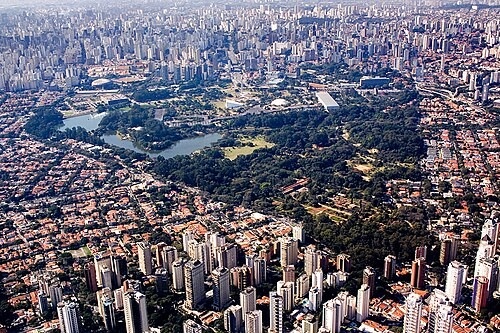
Located in the heart of São Paulo, Ibirapuera Park is one of the largest and most iconic urban parks in Brazil. Covering over 1.5 million square meters, this lush green space offers a perfect escape from the fast-paced city life, combining natural beauty, cultural landmarks, and recreational activities. Opened in 1954, the park has become an integral part of the city’s identity, drawing locals and tourists alike who come to enjoy its stunning landscapes, modernist architecture, and world-class museums. Whether you’re seeking relaxation, outdoor activities, or cultural exploration, Ibirapuera Park has something for everyone.
🌟 Highlights of Ibirapuera Park
• 🌳 Expansive Green Spaces
Ibirapuera Park is a lush haven with vast expanses of grass, shaded walking paths, and tranquil lakes. The park is perfect for leisurely strolls, jogs, or even a peaceful picnic. The large Pond of Ibirapuera adds to the park’s serene environment, where you can enjoy the sight of swans and other waterfowl gliding across the water. It’s also a great spot to relax, meditate, or simply enjoy nature.
• 🏛️ Modernist Architecture
One of the most striking features of Ibirapuera Park is its modernist architecture, with designs by famous Brazilian architect Oscar Niemeyer. The Ibirapuera Auditorium (Auditorio Ibirapuera) and the Obelisk of São Paulo are iconic structures that showcase Niemeyer’s signature curves and clean lines. The park also houses the Oca Pavilion, a large, tent-like building that often hosts exhibitions and cultural events.
• 🎨 Museums and Cultural Spaces
Ibirapuera Park is home to several important cultural institutions:
- Museum of Modern Art (MAM): This museum features a stunning collection of Brazilian and international modern art, including works by Tarsila do Amaral, Candido Portinari, and Anita Malfatti.
- The Afro-Brazilian Museum: Dedicated to the history and contributions of Afro-Brazilian culture, this museum offers exhibits on African heritage, slavery, and cultural identity.
- The Contemporary Art Museum (MAC): Located at the edge of the park, this museum features a rich collection of contemporary art, both national and international.
- The Biennial Pavilion: Home to the São Paulo Art Biennial, one of the most important art events in Latin America, this pavilion hosts a range of contemporary exhibitions.
• 🏞️ The Ibirapuera Auditorium
Designed by Oscar Niemeyer, the Ibirapuera Auditorium is a striking piece of modern architecture. Its unique curves and design make it one of the park’s most admired features. The auditorium regularly hosts concerts, theatrical performances, and cultural events, making it a vibrant spot for arts and entertainment in the park.
• 🚴♂️ Recreational Activities
Ibirapuera Park is a hub for outdoor activities, offering numerous opportunities for exercise and fun. The park has dedicated biking paths, jogging trails, and outdoor gyms, making it a favorite spot for fitness enthusiasts. Bike rentals are available for those who want to cycle around the park, and there are also plenty of spots for rollerblading and skateboarding.
• 🌸 Botanical Gardens
The park also features beautifully landscaped gardens, including a Botanical Garden with a variety of plants, flowers, and trees. It’s a peaceful spot to enjoy the colorful blooms and lush greenery while taking in the natural beauty of the park. The garden is ideal for nature lovers and photographers.
• 🌞 Relaxing Green Areas
Ibirapuera Park has a wide variety of green areas where visitors can simply relax and enjoy the outdoors. Whether you’re lying on the grass, reading a book under a tree, or people-watching, the park offers ample spaces to unwind.
🚗 How to Get There
• By Public Transport:
Ibirapuera Park is easily accessible by public transportation. The São Paulo Metro serves the park through Vila Mariana Station (Line 1 – Blue), which is a short walk away from the park’s entrance. Several bus lines also pass by the park, including Line 509A-10 and Line 875J-10.
• By Car:
The park is located in the Moema and Vila Mariana neighborhoods and is easily reachable by car from many parts of the city. There is parking available at various points around the park, though it can fill up quickly on weekends, so it’s recommended to arrive early if driving.
• By Bike:
São Paulo has many bike paths, and Ibirapuera Park is well-connected to the city’s cycling network. There are bike racks near the entrances of the park where you can park your bike while you explore the park’s trails and attractions.
🕒 Visitor Information
• Opening Hours:
Ibirapuera Park is open daily from 5:00 AM to 12:00 AM, making it a great destination for both early risers and evening visitors. Some attractions within the park, such as museums and cultural spaces, may have different opening hours, typically from 10:00 AM to 6:00 PM.
• Admission Fees:
- Ibirapuera Park: Free to enter, making it a great budget-friendly destination for both locals and tourists.
- Museums: The park’s museums may charge an entrance fee, though the Museum of Modern Art offers free entry on Sundays.
• Accessibility:
The park is fully accessible for people with disabilities, with paved paths, wheelchair ramps, and accessible toilets. Many areas are designed to be easily navigable for those with mobility impairments.
💡 Travel Tips
• 🎨 Visit the Museums:
If you’re an art lover, plan to spend some time exploring the Museum of Modern Art and MAC. They’re both renowned for their impressive collections, and there are often temporary exhibitions that are worth checking out.
• 🎤 Check Out the Events:
Ibirapuera Park is a cultural hub, hosting events such as concerts, theater performances, festivals, and exhibitions. If you’re visiting during one of the many festivals, such as the São Paulo International Film Festival, be sure to check the event schedule in advance to catch something special.
• 🚴♀️ Rent a Bike:
If you enjoy cycling, consider renting a bike to explore the park’s extensive trails. The park is popular with cyclists, and there are several rental shops nearby.
• 🍴 Food & Drink:
While there are plenty of food stalls and cafes around the park, it’s a good idea to bring your own snacks or picnic, especially if you plan to spend several hours in the park. There are many beautiful spots where you can sit and enjoy a homemade meal while taking in the surroundings.
• 🌞 Go Early or Late:
Ibirapuera Park can get quite crowded, especially on weekends. For a more peaceful experience, try to visit early in the morning or later in the evening, when the crowds thin out, and the park has a more tranquil atmosphere.
Ibirapuera Park is more than just a green space; it’s a cultural hub, a peaceful retreat, and a symbol of São Paulo’s urban life. Whether you’re exploring its world-class museums, enjoying the beautiful landscapes, or participating in outdoor activities, the park offers something for everyone. It’s the perfect place to escape the busy city streets, recharge, and immerse yourself in the natural beauty and rich cultural offerings of one of São Paulo’s most treasured landmarks.
Municipal Market (Mercadão)
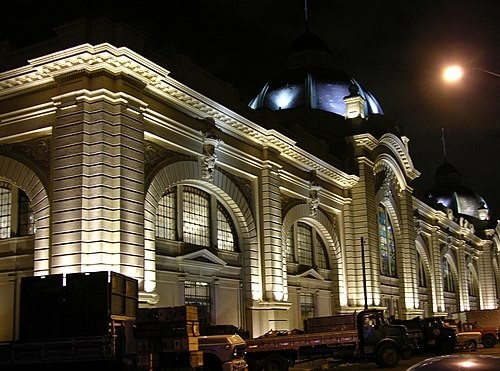
Located in the heart of São Paulo, the Municipal Market (Mercadão) is a vibrant and bustling food market that offers an authentic taste of Brazilian gastronomy. With over 80 years of history, Mercadão is one of the city’s most iconic landmarks, drawing both locals and tourists who come to experience its rich variety of fresh produce, gourmet delicacies, and traditional Brazilian flavors. Whether you’re a foodie, a culinary enthusiast, or just looking to enjoy the local atmosphere, the Mercadão is a must-visit destination.
🌟 Highlights of the Municipal Market (Mercadão)
🥖 Fresh Local Produce
• An Explosion of Flavors
The Mercadão is a feast for the senses, with aisles lined with fresh fruit, vegetables, herbs, and spices. You’ll find exotic fruits like açaí, cupuaçu, and cabeludinha, as well as local Brazilian ingredients like cassava, dende oil, and an endless array of fresh tropical fruits. The market is an ideal place for those wanting to explore the rich variety of flavors that Brazil has to offer.
🍗 Gourmet Food Stalls
• Savor Traditional Brazilian Dishes
The Mercadão is famous for its incredible variety of food stalls serving up traditional Brazilian dishes like feijoada (a hearty black bean stew), pão de queijo (cheese bread), pastéis (fried pastry filled with various ingredients), and coxinhas (chicken croquettes). Don’t miss trying the Bolinho de Bacalhau (salted codfish cakes) or the Mortadella Sandwich, which is legendary for its generous portions and mouth-watering flavor.
🧀 Cheese and Deli Delights
• Gourmet Cheese and Charcuterie
The Mercadão is also home to several cheese stalls where you can sample and purchase a variety of Brazilian cheeses, such as Minas, Canastra, and coalho. For fans of fine meats, you’ll find a selection of high-quality charcuterie from local producers, making it a perfect place for food lovers and culinary explorers.
🍷 Brazilian Wines and Cachaça
• Sip and Savor
Pair your food with some of Brazil’s finest wines and cachaça (the local sugarcane spirit used to make caipirinhas). The market is home to several wine shops offering tastings of Brazilian wines, which are becoming increasingly popular internationally. You can also explore a wide range of cachaça options, each with its own unique flavors and characteristics.
🥥 Exotic and Regional Products
• Unique Regional Goods
For those interested in exploring regional products, the Mercadão offers an array of local specialties, including tapioca flour, palm hearts, dried meats, and Brazilian sweets. There are also plenty of imported goods from other Latin American countries, making it an international food hub within São Paulo.
🍰 Pastry Heaven
• Sweet Treats to Satisfy Any Craving
If you have a sweet tooth, you’ll find an incredible selection of Brazilian desserts such as brigadeiro (chocolate truffles), beijinho (coconut truffles), and quindim (a coconut custard). The market’s pastry shops also feature a variety of cakes, tarts, and other treats, perfect for a snack or to take home.
🚗 How to Get There
By Public Transport
• Metro
The Mercadão is easily accessible via São Paulo’s metro system. The nearest metro station is São Bento (Line 1 – Blue Line), located just a short walk from the market. You can also take the Line 3 – Red Line and get off at Sé station, which is only about a 10-minute walk from the market.
• Bus
Several bus lines pass through the area, making it convenient to reach the Mercadão by public bus. Bus routes include Routes 8012-10 and 975M-10. Check local transport maps for the most convenient routes based on your location.
By Taxi or Ride-sharing
• Taxis and ride-sharing services like Uber and 99 are readily available throughout São Paulo. If you’re staying in popular tourist areas like Avenida Paulista, it should take about 10-15 minutes to reach the Mercadão by taxi.
By Foot
• The Mercadão is located in the downtown area of São Paulo, so if you’re staying in the historic center, you can easily walk to the market. It’s a great way to explore the city’s architecture and vibrant street life as you head to the market.
🕒 Visitor Information
Opening Hours
• Monday to Saturday: The Mercadão is open from 6:00 AM to 6:00 PM.
• Sundays: The market is typically closed on Sundays, though some stalls may open for special events or holidays.
• Closed on Public Holidays: Be sure to check the market’s schedule ahead of time if you’re visiting on a public holiday.
Entry Fee
• There is no entrance fee to visit the Mercadão. Visitors are welcome to browse the stalls, shop for fresh produce, and enjoy the sights and smells of the market without any charge.
Recommended Visit Duration
• 1 to 2 Hours: You can comfortably explore the Mercadão in 1 to 2 hours. If you plan to sample the food, take time to sit down at one of the food stalls, you may want to spend a bit longer.
💡 Travel Tips
🎫 Try the Legendary Mortadella Sandwich
• The Mortadella sandwich at Hocca Bar inside the Mercadão is a must-try for anyone visiting. It’s known for its massive size and generous portions of mortadella, making it a culinary highlight. Be sure to grab a seat at the counter for an authentic experience.
🛍️ Shop for Souvenirs
• If you want to take home a taste of Brazil, the Mercadão is a great place to buy local food products. Look for regional treats, Brazilian coffee, and dried fruits to bring home as souvenirs.
👟 Wear Comfortable Shoes
• The Mercadão can get crowded, especially on weekends, and involves a lot of walking. Make sure to wear comfortable footwear to enjoy your time at the market.
🍽️ Cash and Cards
• Most stalls and food counters accept credit cards, but it’s a good idea to carry cash (especially reais) for smaller purchases, as some vendors may prefer cash transactions.
🌟 Visit on Weekdays
• If you want to avoid the crowds, visit on weekdays. The market is particularly busy on Saturdays, so visiting earlier in the day can make your experience more enjoyable.
The Municipal Market (Mercadão) is a true gastronomic gem in São Paulo, offering an unforgettable sensory experience for anyone interested in discovering Brazilian food culture. With its vibrant atmosphere, diverse food options, and historical charm, Mercadão offers much more than just a place to shop—it’s a place to experience the soul of São Paulo. Whether you’re a local or a tourist, a visit to the Mercadão will leave you with lasting memories and a full belly!
Liberdade District
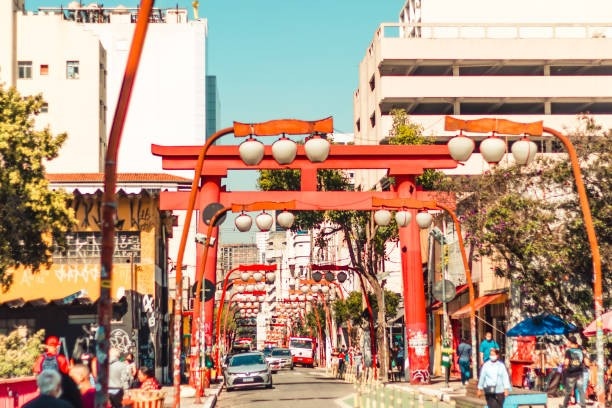
Nestled in the heart of São Paulo, Liberdade District is a lively cultural enclave celebrated as the largest Japanese community outside Japan. Known for its colorful lanterns, bustling markets, and authentic Asian cuisine, Liberdade offers visitors a unique blend of tradition and modern urban life. Whether you’re exploring its shops, tasting street food, or joining cultural festivals, Liberdade is a must-visit destination for anyone wanting to experience São Paulo’s rich multicultural fabric.
🌟 Highlights of Liberdade District
• 🛍️ Traditional Markets & Shops
Discover shops selling Japanese crafts, souvenirs, anime merchandise, and specialty foods like matcha tea and mochi sweets.
• 🍜 Authentic Asian Cuisine
From ramen and sushi bars to Chinese dim sum and Korean BBQ, Liberdade is a food lover’s paradise offering flavors from across East Asia.
• 🎎 Cultural Festivals
Experience vibrant events such as the Tanabata Festival, Lunar New Year celebrations, and the annual Matsuri with traditional dance, music, and street performances.
• 🏮 Iconic Red Lanterns & Street Decor
Stroll beneath the iconic red lanterns and Torii gates that adorn the streets, creating a visually stunning and immersive atmosphere.
• 🏯 Cultural Centers & Temples
Visit local temples like the Liberdade Shinto Shrine or cultural centers promoting Japanese art, language, and heritage.
🚇 How to Get There
• By Metro:
Take Line 1 (Blue Line) to Liberdade Station—the easiest and most convenient way to reach the district.
• By Bus:
Several bus lines serve the area; check local routes for stops along Rua Galvão Bueno or Rua da Glória.
🕒 Visitor Information
• Opening Hours:
Shops and markets generally open from late morning until early evening; weekends are especially lively.
• Best Time to Visit:
Weekends, especially during festivals, offer the fullest experience. Evenings bring a charming ambiance with illuminated lanterns.
💡 Travel Tips
• 👟 Comfortable Footwear Recommended:
Explore the bustling streets and markets on foot.
• 📸 Bring Your Camera:
Perfect for capturing vibrant street scenes, market stalls, and colorful decorations.
• 🍽️ Try Street Food:
Don’t miss out on popular treats like takoyaki, yakisoba, and taiyaki from food stalls.
• 🎁 Shop for Unique Souvenirs:
Look for traditional ceramics, Japanese stationery, and specialty snacks to take home.
Liberdade District is a cultural gem in São Paulo that beautifully blends Asian heritage with Brazilian energy. Whether you’re here for the food, shopping, festivals, or simply to soak in the atmosphere, Liberdade offers a fascinating glimpse into one of the city’s most vibrant communities.
Pinacoteca do Estado
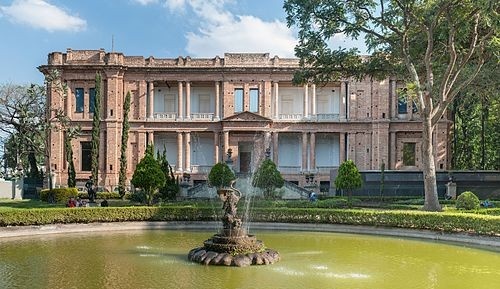
Located in the heart of São Paulo, the Pinacoteca do Estado is one of Brazil’s premier art museums. Founded in 1905, it houses a vast collection of Brazilian art from the 19th century to contemporary works. The museum’s neoclassical architecture and serene Pinacoteca Garden add to the cultural experience, making it a must-visit for art lovers and history buffs alike.
🌟 Highlights of Pinacoteca do Estado
🖼️ Art Collection
• Brazilian Masterpieces
The museum holds over 8,000 works including iconic pieces by Tarsila do Amaral, Candido Portinari, and Emiliano Di Cavalcanti.
🖌️ Temporary Exhibitions
• Global Art Showcase
Pinacoteca regularly hosts exhibitions featuring both Brazilian and international artists, offering fresh perspectives on contemporary art.
🌳 Stunning Architecture & Gardens
• Beautiful Interiors & Outdoors
The museum combines neoclassical architecture with modern elements. The Pinacoteca Garden provides a peaceful escape with sculptures and lush greenery.
🎨 Educational Programs
• Art Workshops & Tours
The museum offers a variety of workshops and guided tours to help visitors engage with the artwork on a deeper level.
🚗 How to Get There
• By Metro: The museum is a 10-minute walk from São Bento Metro Station (Blue Line) and Luz Station (Lines 1 & 4).
• By Taxi/Ride-sharing: Easily accessible from anywhere in São Paulo, located in the Luz neighborhood.
• By Foot: Within walking distance from República or Bela Vista neighborhoods.
🕒 Visitor Information
• Opening Hours: Tuesday to Sunday from 10:00 AM to 5:00 PM. Closed on Mondays.
• Entry Fee: Regular admission is about R$10, with free entry on Tuesdays.
• Recommended Visit Duration: Plan to spend around 1.5 to 2 hours exploring the museum.
💡 Travel Tips
• 🎟️ Buy Tickets Early: Pre-book tickets, especially for special exhibitions.
• 🕶️ Relax in the Garden: Don’t miss the Pinacoteca Garden—a tranquil spot to unwind.
• 👟 Comfortable Shoes: Wear comfy shoes as the museum spans multiple floors.
Pinacoteca do Estado is a cultural gem in São Paulo, offering a captivating look into Brazilian art and history. With its iconic collection, stunning architecture, and serene gardens, it’s a must-visit for anyone exploring the city’s artistic heritage. Whether you’re an art enthusiast or just looking for a peaceful retreat, the Pinacoteca provides an enriching experience.
Cathedral da Sé & Praça da Sé
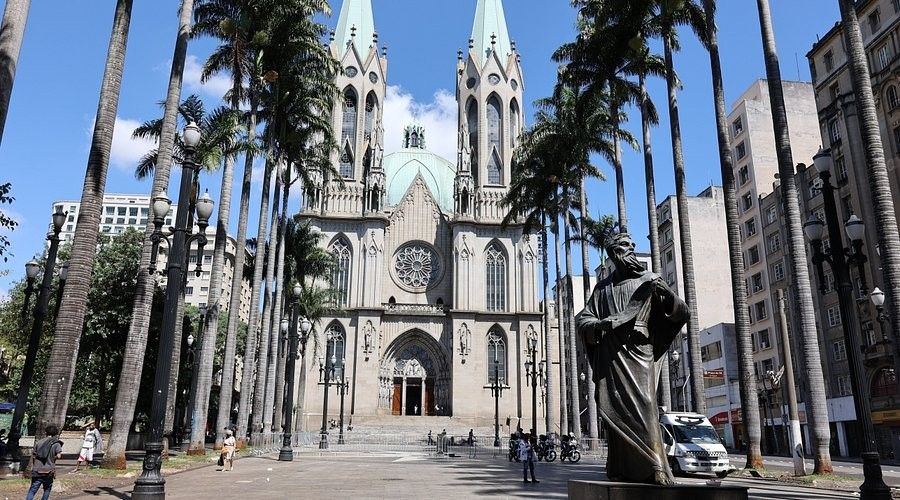
Cathedral da Sé, also known as the São Paulo Metropolitan Cathedral, stands proudly at the heart of São Paulo, right in Praça da Sé, one of the city’s most iconic squares. As the largest church in Brazil and one of the largest neo-Gothic structures in the world, the Cathedral da Sé is not only a religious landmark but also an architectural masterpiece. The cathedral is a symbol of São Paulo’s spiritual heritage, and Praça da Sé serves as a lively public space that connects the city’s rich history with its modern identity.
Whether you’re drawn to the cathedral’s awe-inspiring architecture or the vibrant energy of the square, both the cathedral and the surrounding area offer visitors a deep dive into São Paulo’s cultural and historical roots.
🌟 Highlights of Cathedral da Sé & Praça da Sé
• ⛪ São Paulo Cathedral
The Cathedral da Sé is one of the most stunning examples of neo-Gothic architecture in Brazil. Construction began in 1913 and was completed in 1967, and the cathedral’s massive size and intricate details make it a marvel. Visitors can admire its twin spires that rise 92 meters above the square, making it an unmistakable feature of the São Paulo skyline. Inside, the cathedral features beautiful stained glass windows, sculpted columns, and an impressive altar that showcases a blend of traditional Gothic elements with Brazilian artistic touches.
• 🕍 The Cathedral’s Interior
Step inside to experience the awe-inspiring interior of the Cathedral da Sé. The vast, high-ceilinged nave and towering pillars create an air of majesty. The stained glass windows depict scenes from the life of Christ and saints, adding a colorful vibrancy to the sacred space. Visitors can also explore the crypts beneath the cathedral, which contain the remains of several notable figures, including former archbishops of São Paulo.
• 🌳 Praça da Sé
Right in front of the Cathedral lies Praça da Sé, one of São Paulo’s most important public squares. This bustling square is framed by the magnificent cathedral on one side and historic buildings on the other, making it a prime spot for sightseeing and people-watching. The large, open space is often home to street performers, markets, and local events, bringing the square to life with energy and activity.
• 🚶♂️ Historical Significance
Praça da Sé is a significant location in São Paulo’s history. It is the city’s historic center and has been a focal point for centuries. Originally home to indigenous villages, it became a vital hub with the arrival of Portuguese colonizers. The square has undergone several transformations over the years, evolving into the cultural and administrative heart of São Paulo.
• 💫 The Monument to the Heroes of the Constitution
At the center of Praça da Sé stands the Monument to the Heroes of the Constitution, a statue commemorating the Brazilian Revolution of 1932. The monument consists of a large pedestal and sculptures depicting figures from the conflict, symbolizing the struggle for democracy and national unity.
• 🎥 Photography and Scenic Views
Praça da Sé is an excellent spot for photography. Whether you’re capturing the dramatic architecture of the cathedral, the vibrant street life, or the towering cityscape, there’s always something interesting to capture. The view from the front steps of the cathedral offers a great perspective of the square and the busy streets surrounding it.
🚗 How to Get There
• By Public Transport:
The São Paulo Metro is the easiest and most efficient way to reach both Cathedral da Sé and Praça da Sé. The Sé Station (Lines 1 – Blue and Line 3 – Red) is directly beneath the square, allowing visitors to exit directly into the heart of the action. The metro station is well-connected to other parts of the city, making it simple to reach the area from any neighborhood.
• By Car:
While public transport is often recommended due to the city’s traffic, if you’re driving, the area is easily accessible via Avenida Tiradentes or Rua da Sé. Keep in mind, though, that parking in this part of São Paulo can be limited and challenging to find, especially during peak hours.
• By Bike:
São Paulo has a growing network of bike lanes, and Praça da Sé is accessible by bike as well. There are bike-sharing services, such as Bike Sampa, where you can rent a bike to explore the area. If cycling, it’s best to park your bike in designated spots around the square.
🕒 Visitor Information
• Opening Hours:
- Cathedral da Sé is generally open every day from 7:00 AM to 6:00 PM for visitors, with mass services taking place several times a day.
- The Crypts beneath the cathedral can be accessed during opening hours, but you may want to check ahead for special tours.
• Admission Fees:
- Cathedral da Sé: Free to enter, making it an accessible and must-see destination for visitors of all ages.
- Crypt Tour: Some tours of the cathedral crypt may involve a small fee.
- Special Events or Services: For major events or religious ceremonies, such as weddings or religious festivals, there may be restrictions on visitor access.
• Accessibility:
The cathedral and surrounding square are accessible to people with disabilities, with ramps and elevators available in some areas. The Sé Station is also equipped with facilities for those with mobility impairments.
💡 Travel Tips
• ⛪ Attend a Mass:
If you’re visiting during a religious service, attending mass at Cathedral da Sé is a moving experience. The ornate interior, coupled with the solemn atmosphere, makes for a truly memorable visit. The cathedral’s grand acoustics enhance the beauty of the liturgy.
• 🎭 Explore Surrounding Landmarks:
After visiting the cathedral, take some time to explore other nearby historic landmarks. Just a short walk away, you’ll find the Pátio do Colégio, the birthplace of São Paulo, and the Theatro Municipal, one of Brazil’s most important opera houses.
• 📷 Bring Your Camera:
The architecture of Cathedral da Sé and the lively Praça da Sé offer excellent photo opportunities. Whether you’re capturing the gothic beauty of the cathedral or the dynamic atmosphere of the square, it’s a great place for both architecture and street photography.
• 🍴 Food and Drink:
While Praça da Sé itself may not be packed with restaurants, you’ll find plenty of dining options in the nearby streets of Rua 25 de Março and Rua do Mercado. These areas are famous for traditional Brazilian foods, street vendors, and local cafés. Don’t miss out on trying pão de queijo (cheese bread) or pastéis (fried pastries).
• 💥 Avoid Peak Hours:
The area around the cathedral and square can be quite busy, particularly during lunch hours and weekends. To avoid the crowds, try to visit early in the morning on weekdays for a quieter, more peaceful experience.
Cathedral da Sé and Praça da Sé offer visitors a window into São Paulo’s rich historical and cultural fabric. The cathedral’s majestic neo-Gothic design, combined with the lively energy of the square, make this a must-visit for anyone exploring the city. Whether you’re interested in history, architecture, or simply soaking in the ambiance of one of São Paulo’s busiest public spaces, the cathedral and square are an essential stop in your São Paulo journey.
Beco do Batman

Tucked away in the vibrant neighborhood of Vila Madalena, Beco do Batman (Batman Alley) is a must-visit destination for art lovers and anyone keen to explore São Paulo’s thriving street art scene. Renowned for its colorful murals, graffiti, and creative expressions, this alley has become one of the city’s most iconic landmarks, attracting visitors from all over the world. Over the years, Beco do Batman has transformed from a forgotten, neglected alley into a vibrant open-air gallery that showcases the artistic pulse of the city.
🌟 Highlights of Beco do Batman
🎨 Street Art and Murals
• A Canvas of Creativity
Beco do Batman is a street art haven, where artists from around the world come to showcase their talent. The walls are constantly changing, with new murals and graffiti pieces appearing all the time. The alley is covered with everything from abstract art, portraiture, political messages, and vivid color splashes to more intricate, large-scale murals. It’s an incredible spot to see São Paulo’s ever-evolving art scene in real time.
👩🎨 Local and International Artists
• Collaborative Art Space
Beco do Batman has hosted numerous local artists as well as international street art legends. Famous artists like Os Gêmeos, Kobra, and Eduardo Kobra have left their mark on the alley, alongside many lesser-known but equally talented creatives. The space is free and open for anyone to leave their artistic imprint, making it a true collaborative effort.
📸 Perfect for Photos
• Instagram Heaven
If you love taking photos, Beco do Batman is an absolute Instagram paradise. The vibrant colors and ever-changing designs make it a photographer’s dream. Whether you’re snapping shots of the artwork, the quirky characters painted on the walls, or just soaking in the urban vibes, every corner of the alley provides a new photo opportunity.
🎭 Cultural Events and Festivals
• Art Exhibitions and Performances
Besides the murals, Beco do Batman also hosts cultural events such as art exhibitions, live performances, and music events. These events often bring together a diverse community of artists, performers, and locals, making the alley a dynamic space for cultural exchange. If you visit during a special event, you’ll experience the energy and creative buzz that make the area so unique.
🖌️ Vibrant Neighborhood
• Vila Madalena
The alley itself is part of the Vila Madalena neighborhood, which is known for its bohemian vibe and artistic spirit. The surrounding streets are lined with art galleries, boutiques, cafés, and bars, all contributing to the laid-back, creative atmosphere of the area. After exploring Beco do Batman, you can wander around Vila Madalena and enjoy the local art scene.
🚗 How to Get There
By Public Transport
• Metro
The closest metro station to Beco do Batman is Vila Madalena (Line 2 – Green Line), which is about a 15-minute walk from the alley. From there, it’s easy to follow the colorful signs that guide you toward the alley.
• Bus
Several bus routes pass through Rua dos Três Irmãos and Rua Mourato Coelho, which are close to Beco do Batman. Use São Paulo’s public transport website or apps to check the best routes.
By Taxi or Ride-sharing
• Taxis and ride-sharing services like Uber and 99 are readily available throughout the city. If you’re in the central area or near Paulista Avenue, it should take about 15-20 minutes to reach Beco do Batman by car.
By Foot
• If you’re staying nearby in the Vila Madalena or Pinheiros areas, walking to Beco do Batman is a great option. The alley is located in a lively neighborhood, so you’ll get to explore the vibrant streets while heading there.
🕒 Visitor Information
Opening Hours
• Always Open
Beco do Batman is an open-air public space, so it’s accessible 24 hours a day, 7 days a week. However, to fully experience the artwork and atmosphere, it’s best to visit during the daylight hours, when the murals are most visible and the neighborhood is lively.
Entry Fee
• Free Entry
There is no entrance fee to visit Beco do Batman. It’s completely free to explore, take photos, and admire the artwork, making it an affordable destination for everyone.
Recommended Visit Duration
• 30 Minutes to 1 Hour
If you’re simply strolling and enjoying the art, about 30 minutes to an hour should be enough to take in the vibrant murals. However, if you plan to explore the surrounding neighborhood or take photos, you may want to spend a little more time.
💡 Travel Tips
📸 Bring Your Camera
• Beco do Batman is a photographer’s dream, so make sure to bring your camera or smartphone to capture the incredible street art. The murals often change, so each visit may offer something new to photograph.
👟 Wear Comfortable Shoes
• The alley and surrounding neighborhood are best explored on foot. Wear comfortable shoes so you can wander through the area and enjoy the local galleries, cafés, and shops.
🚶♂️ Explore the Surroundings
• After visiting Beco do Batman, take time to explore the rest of Vila Madalena. The area is known for its bohemian vibe, with cool shops, art galleries, and bars. It’s a great place to relax, grab a coffee, or explore local stores.
🛍️ Buy Local Art
• If you’re interested in taking home a piece of São Paulo’s street art scene, the neighborhood is home to local art shops and galleries where you can purchase prints, paintings, or handcrafted items.
🕶️ Avoid Peak Hours for a Quieter Experience
• If you prefer a quieter experience, try visiting early in the morning or on weekdays. The alley can get crowded, especially on weekends, as it’s a popular spot for tourists and locals alike.
Beco do Batman is more than just an alley—it’s a celebration of urban creativity and a testament to São Paulo’s thriving street art culture. Whether you’re an art enthusiast, a photographer, or simply curious about the local scene, a visit to Beco do Batman offers a unique opportunity to experience the artistic heart of São Paulo. The vibrant murals, the bohemian vibe of Vila Madalena, and the ever-changing street art make it a memorable experience that captures the soul of the city.
Football Museum (Museu do Futebol)
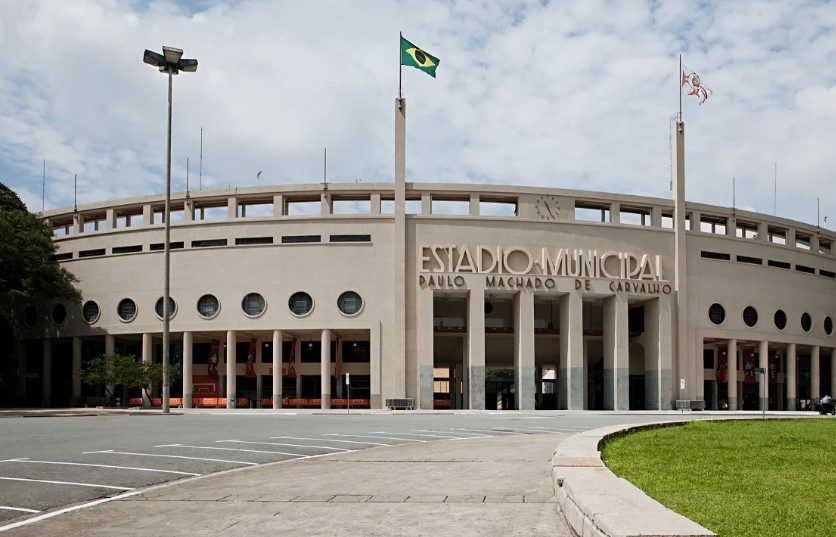
Located in the heart of São Paulo, Museu do Futebol (Football Museum) is one of Brazil’s most unique and engaging museums, dedicated to the country’s unwavering passion for football (soccer). Situated inside the iconic Pacaembu Stadium, the museum immerses visitors in the rich history, culture, and emotions tied to the world’s most beloved sport. Through interactive exhibits, historical artifacts, and multimedia displays, the Football Museum offers an insightful journey through Brazil’s football legacy, from the early days of the sport to its current status as a global phenomenon.
Whether you’re a football fan or simply curious about the cultural importance of the sport in Brazil, this museum is a must-visit for anyone wanting to understand why football holds such a special place in the heart of the nation.
🌟 Highlights of the Football Museum
• ⚽ The History of Brazilian Football
The Football Museum takes you on a journey through Brazil’s football history, highlighting significant moments, players, and teams that shaped the sport in the country. From the early 20th century to the World Cup triumphs, the museum covers key milestones in Brazil’s football evolution, including the legendary Pelé, Ronaldo, and the Brazilian National Team’s incredible World Cup successes.
• 📱 Interactive Exhibits
One of the standout features of the museum is its interactive exhibits. Through immersive displays and hands-on activities, visitors can experience what it feels like to be on the field, hear the roar of a stadium full of fans, or even test their skills in virtual games. The museum’s technology-driven approach makes it an exciting destination for visitors of all ages.
• 🏆 The Brazilian National Team
Explore the Brazilian National Team’s triumphs and failures, including its legendary 5 World Cup victories (1958, 1962, 1970, 1994, 2002). The museum showcases key players, such as Zico, Ronaldo, Romário, and Neymar, and their unforgettable contributions to the country’s football history. Visitors can also view memorabilia like jerseys, shoes, and personal items belonging to football icons.
• 🎬 Multimedia Experience
The museum boasts a variety of multimedia displays, featuring videos, documentaries, and audio clips of famous football matches, fan reactions, and commentary. These captivating exhibits help to convey the emotional connection Brazilians have with the sport and highlight the role football plays in national identity.
• ⚽ Football Culture and Society
Beyond the technical aspects of the game, the Football Museum delves into the broader cultural impact of football in Brazilian society. It explores the connection between football and the nation’s social, racial, and political history. Football in Brazil is not just a sport; it’s a form of expression, a way of life, and a catalyst for unity and national pride.
• 🌍 International Influence
While the focus is on Brazilian football, the museum also offers insight into how Brazilian football has influenced the global footballing landscape. Exhibits highlight international matches, legendary rivalries, and Brazil’s role in shaping the way the world plays and loves football.
• 🏟️ The Iconic Pacaembu Stadium
The museum is housed inside the historic Pacaembu Stadium, which adds to the experience. The stadium has been a home to several memorable football matches and remains an important venue for sports in São Paulo. You can even take a stadium tour to explore its rich history after visiting the museum.
🚗 How to Get There
• By Public Transport:
The Museu do Futebol is located in the Pacaembu Stadium, and it is easily accessible by public transport. The nearest metro station is Estação Clínicas (Line 2 – Green), which is about a 15-minute walk to the stadium. Several buses also stop nearby, including Line 701A-10 and Line 875N-10.
• By Car:
If you’re driving, you can access Pacaembu Stadium via Avenida Pacaembu or Rua dos Três Irmãos. There are parking lots near the stadium, but they can fill up quickly, especially on weekends and public holidays.
• By Bike:
São Paulo has a growing network of bike lanes, and you can cycle to the museum using bike paths in the area. Bike racks are available for those wishing to park their bicycles near the stadium.
🕒 Visitor Information
• Opening Hours:
- The Football Museum is open Tuesday to Sunday from 9:00 AM to 6:00 PM.
- It is closed on Mondays and some public holidays, so check ahead if you plan to visit during a holiday season.
- The museum may extend its hours during special events or exhibitions, so be sure to check the website for updates.
• Admission Fee:
- General Admission: Entry typically costs around R$20 (Brazilian Reais).
- Free Entry: The museum offers free entry on Sundays for Brazilian residents or residents of São Paulo, with proof of identification.
- Discounts: Discounts are available for students, seniors, and children.
• Recommended Visit Duration:
Plan to spend 1.5 to 2 hours exploring the museum. While the museum is relatively compact, its interactive and multimedia exhibits make for an engaging visit that can take time to fully appreciate.
💡 Travel Tips
• 🎥 Watch the Videos:
The museum offers a fantastic collection of video clips from memorable football moments, such as World Cup highlights and famous goals. Make sure to take time to sit and watch some of these clips to truly appreciate Brazil’s football history.
• ⚽ Try the Interactive Exhibits:
Don’t miss out on the interactive displays. Whether it’s testing your football skills or experiencing the roar of a stadium crowd, the hands-on exhibits add an extra layer of fun and excitement.
• 📷 Photography:
Feel free to take photos in most parts of the museum. It’s a great opportunity to capture your favorite football moments and memorabilia. Just be mindful of areas where photography might be restricted due to temporary exhibitions or sensitive artifacts.
• 🍴 Food and Drink:
There are food stalls and cafés inside the Pacaembu Stadium where you can grab a quick snack or drink. For more substantial meals, consider exploring the nearby Rua dos Três Irmãos or Rua dos Três Irmãos, where you’ll find a variety of restaurants and local eateries offering Brazilian delicacies.
• 🎟️ Book in Advance:
Though not always necessary, it’s a good idea to book tickets in advance during busy periods, such as holidays or major football events. This can save you time and ensure you don’t miss out on the experience.
The Football Museum is a celebration of Brazil’s unparalleled passion for football and its cultural significance. Whether you’re a football enthusiast or just want to understand the sport’s impact on Brazilian identity, this museum offers a fascinating look at how football weaves itself into the fabric of the nation. From interactive exhibits to historical artifacts, the Museu do Futebol is an unforgettable experience for visitors of all ages.
If you find yourself in São Paulo, don’t miss the opportunity to experience this dynamic tribute to Brazil’s love for the beautiful game!
Theatro Municipal
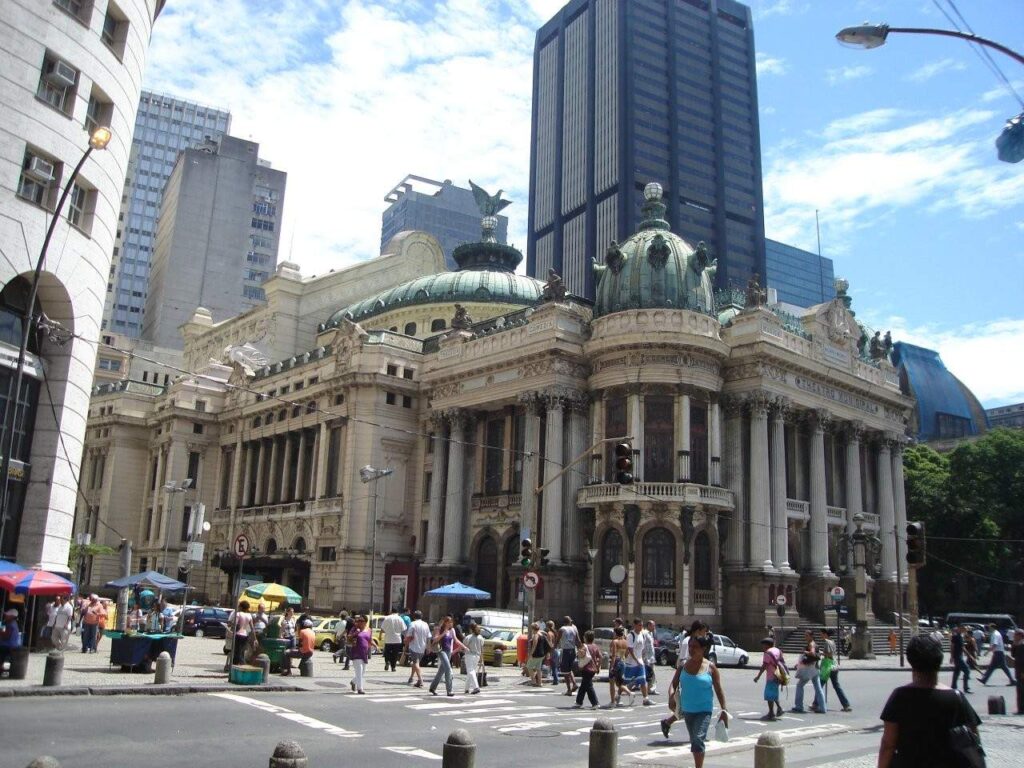
Located in the heart of São Paulo, the Theatro Municipal (Municipal Theatre) is one of Brazil’s most important cultural institutions. This architectural masterpiece is not only a symbol of the city’s cultural heritage but also a hub for world-class performances in opera, ballet, and orchestral music. Opened in 1911, the theatre is a stunning example of Renaissance Revival architecture, blending European influence with Brazilian artistry. Whether you’re an avid fan of the performing arts or simply looking to admire a piece of São Paulo’s rich history, Theatro Municipal is an unmissable destination.
🌟 Highlights of Theatro Municipal
🏛️ Stunning Architecture
• A European-Inspired Masterpiece
The architecture of Theatro Municipal is a visual feast, with intricate facades, grand staircases, and luxurious marble interiors. Designed by Raimundo de Magalhães Júnior and Cláudio Rossi, the building features a mix of Baroque and Renaissance Revival styles, including ornate sculptures, gold leaf detailing, and magnificent frescoes on the ceilings. The front façade is especially striking, with its statues of muses, and it’s considered one of the most beautiful in the city.
🎶 World-Class Performances
• Opera, Ballet, and Classical Music
Theatro Municipal is home to some of the world’s finest performances, including opera, ballet, and symphony concerts. The theatre hosts a variety of performances year-round, showcasing works by legendary composers like Mozart, Verdi, and Tchaikovsky, as well as contemporary pieces. Both Brazilian and international artists perform here, contributing to its global reputation.
🎭 Home to the São Paulo State Symphony Orchestra
• A Cultural Institution
The São Paulo State Symphony Orchestra (OSESP) is one of the most prestigious in Brazil and performs regularly at the Theatro Municipal. It is renowned for its dynamic programming and has become an essential part of São Paulo’s cultural scene. OSESP’s concerts are often conducted by world-class maestros, further enhancing the theatre’s reputation as a center for classical music.
🩰 Ballet and Dance Performances
• A Dance Lover’s Dream
Theatro Municipal also boasts a rich history of ballet performances. The São Paulo Dance Company regularly performs here, as do many international ballet companies. The theatre’s perfect acoustics and spectacular stage make it an ideal setting for a wide range of dance performances, from classical to modern.
🎤 Cultural Events and Festivals
• More than Just a Theatre
In addition to regular performances, Theatro Municipal hosts various cultural festivals throughout the year, such as the Festival de Ópera and the Sesc Jazz Festival. These events draw large crowds and showcase São Paulo’s diversity in cultural programming, from classical music to contemporary genres.
🚗 How to Get There
By Public Transport
• Metro
The closest metro station to Theatro Municipal is Anhangabaú (Line 3 – Red Line), located just a short walk from the theatre. You can also access the São Bento station (Line 1 – Blue Line), which is a 10-minute walk from the theatre.
• Bus
Several bus lines pass through Avenida São João and Avenida Ipiranga, both of which are close to the theatre. Check local transport apps for the most efficient routes.
By Taxi or Ride-sharing
• Taxis and ride-sharing services like Uber and 99 are available throughout São Paulo. If you’re in Avenida Paulista or the central region, it will take about 10-15 minutes to reach Theatro Municipal by taxi or ride-sharing service.
By Foot
• The theatre is located in the city center, and if you’re staying in nearby neighborhoods like República or Bela Vista, it’s an easy 15-minute walk. You’ll pass through the bustling streets of Avenida São João, giving you a taste of the city’s vibrant atmosphere.
🕒 Visitor Information
Opening Hours
• Box Office: The box office is open Monday through Saturday from 10:00 AM to 6:00 PM. It’s closed on Sundays unless there’s a performance.
• Performances: Show times vary depending on the schedule, with most performances starting in the evening around 7:30 PM to 9:00 PM.
• Guided Tours: If you’d like to take a guided tour of the theatre, it’s available on select days and can be booked in advance. The tours typically last 45 minutes to an hour.
Entry Fee
• Ticket Prices: The prices for performances vary depending on the event, seating choice, and the type of performance (opera, ballet, concert, etc.). Ticket prices typically range from R$20 to R$150 for regular shows.
• Guided Tours: Guided tours of the theatre are usually priced between R$20 and R$30 per person.
Recommended Visit Duration
• 1 to 2 Hours: A performance at Theatro Municipal typically lasts between 1 to 3 hours, depending on the event. If you’re taking a guided tour, 1 hour is usually enough to explore the venue.
💡 Travel Tips
🎟️ Buy Tickets in Advance
• Popular Shows: Given the popularity of Theatro Municipal, it’s a good idea to buy tickets in advance, especially for high-demand performances like opera or ballet. Tickets are available online or at the box office.
🕴️ Dress Code
• Smart Casual: While there’s no strict dress code, it’s customary to dress smart casual when attending a performance. For special events like galas or premieres, you may want to opt for formal wear.
👟 Comfortable Footwear
• If you plan on taking a guided tour, wear comfortable shoes, as there’s a bit of walking involved in exploring the grand building.
📸 Photography Restrictions
• No Flash Photography: Flash photography is usually not allowed during performances. However, feel free to take pictures of the theatre’s stunning interior before the show starts or during guided tours.
🍽️ Dining Options
• There are a number of restaurants and cafes near the theatre, especially in the República and Bela Vista neighborhoods. For a fine dining experience, consider visiting the Restaurant do Theatro Municipal, which is located within the venue itself.
The Theatro Municipal is a true cultural gem in São Paulo, offering a remarkable mix of architectural grandeur, world-class performances, and a rich history. Whether you’re attending a high-profile opera, enjoying a mesmerizing ballet, or simply marveling at the stunning design of the theatre, a visit here is a must for anyone seeking to experience São Paulo’s vibrant cultural scene. With its blend of tradition, elegance, and modernity, Theatro Municipal captures the essence of Brazil’s artistic legacy.
📝 Local Travel Tips
- 🚇 Use the Metro: Clean, safe, and affordable — avoid rush hour for a more pleasant ride.
- 🍴 Eat like a local: Try feijoada (black bean stew), pão de queijo (cheese bread), and brigadeiro (chocolate truffles).
- 📱 Stay connected: SIM cards with data are widely available at airports and shopping malls.
- 📷 Street Safety: São Paulo is generally safe in tourist zones, but avoid displaying valuables openly.
- 💰 Tipping: 10% is usually included in restaurant bills; no need to tip taxis unless for excellent service.
📌 Additional Information
- Wi-Fi: Widely available in hotels, cafes, and parks.
- Festivals to Catch:
- São Paulo Carnival (Feb/Mar): A more underground, street-party version of Rio’s famous event.
- Virada Cultural (May): 24 hours of free music, theater, and arts across the city.
- São Paulo International Film Festival (October): A must for cinema lovers.
- Shopping Areas: Rua Oscar Freire for luxury brands, 25 de Março for local bargains, and Shopping Iguatemi for everything in between.
- Souvenirs to Buy: Brazilian coffee, local art, football jerseys, and handmade crafts.
✨ Final Thoughts
São Paulo may not have beaches like Rio, but it thrives on its rhythm — fast-paced, flavorful, and full of heart. From its ever-evolving art scene to the deeply rooted traditions found in every neighborhood, São Paulo is a city that embraces contrasts and celebrates diversity.
Come for the energy, stay for the culture — and let this incredible city surprise you at every turn.✨

I’m Shreyash Mhashilkar, an IT professional who loves building user-friendly, scalable digital solutions. Outside of coding, I enjoy researching new places, learning about different cultures, and exploring how technology shapes the way we live and travel. I share my experiences and discoveries to help others explore new places, cultures, and ideas with curiosity and enthusiasm.

